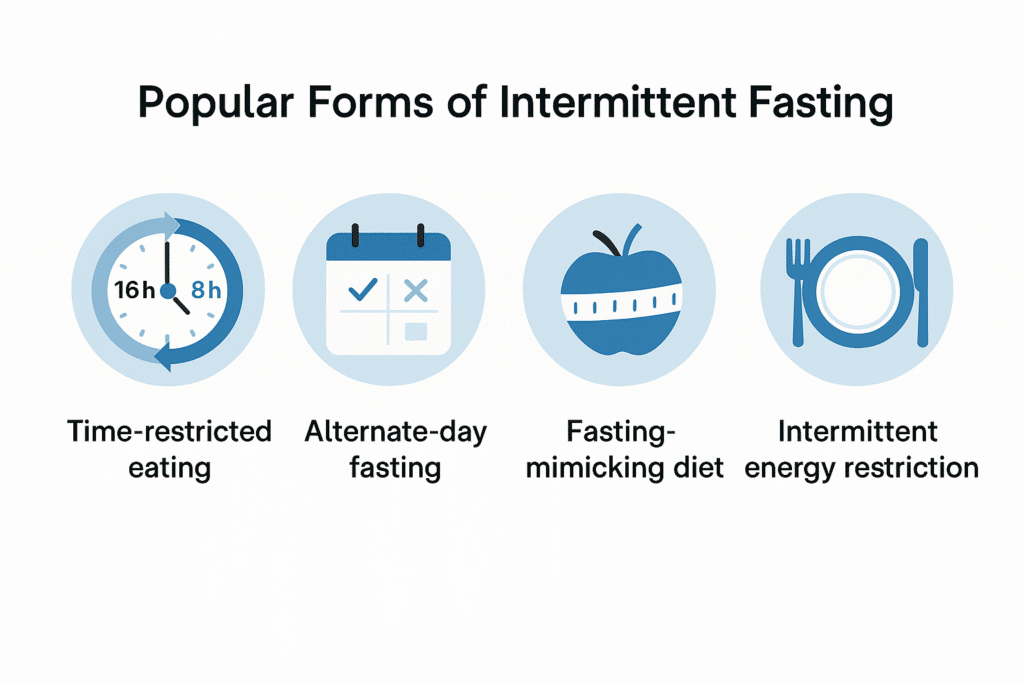When Healthy Habits Become Harmful
From Instagram reels to Reddit threads, intermittent fasting is now part of the latest trends in wellness. It’s everywhere praised as a shortcut to health benefits, fat loss, and even longevity. Unlike restrictive diets that obsess over calories or food types, intermittent fasting (IF) simply focuses on when you eat, not what. But in a world drowning in diet culture, is intermittent fasting an eating disorder, or a misunderstood eating strategy being misused under the illusion of control?

Behind the transformations and time-lapse photos are real people, some thriving, others quietly battling guilt, obsession, and emotional turmoil.
“Fasting isn’t dangerous in itself. It’s what fuels the habit that matters most.”
What Is Intermittent Fasting?
Intermittent fasting is an eating pattern strategy that alternates between periods of eating and fasting, without necessarily changing the types of foods consumed.
It works by triggering a metabolic switch, where the human body transitions from using glucose to ketone bodies as its main fuel source. This switch is believed to promote insulin sensitivity, fat loss, and even reduce cardiovascular disease risk in some populations.
Popular forms of intermittent fasting include:
- Time-restricted eating (like the 16:8 method)
- Alternate-day fasting
- Fasting-mimicking diet
- Intermittent energy restriction

Each approach controls the number of hours you’re allowed to eat, offering different ways to align with your lifestyle and energy needs.
Many people experience short term improvements like sharper cognitive functions and reduced cravings. However, much of the current data stems from preclinical studies and lacks the scope of longitudinal studies needed to measure clinically important outcomes over the long term.
“Fasting may support your health, but it’s not the best choice for everyone, and certainly not without context.”
Is intermittent fasting an eating disorder
As IF gains traction, it’s important to explore how it differs from clinically recognized eating disorders such as anorexia nervosa or bulimia nervosa. These distinctions are not always obvious on the surface but are critical to prevent misuse.
The biggest difference lies in motivation. Intermittent fasting is often goal-based and flexible, while eating disorders are rigid, compulsive, and driven by fear or shame.
| Criteria | Intermittent Fasting | Eating Disorder (e.g., Anorexia, Bulimia) |
|---|---|---|
| Goal | Health, structure, energy balance | Control, punishment, and body image obsession |
| Flexibility | Can be paused or adjusted | Rigid, compulsive, inflexible |
| Physical Impact | May improve body weight and metabolism | Causes serious medical complications |
| Mental State | Can feel empowering or neutral | Often associated with anxiety, guilt, and obsession |
| Social Life | May allow social eating | Usually isolating or secretive |
| Relationship with Food | Ideally mindful and intuitive | Driven by fear, guilt, and restriction |
“It’s not the eating window that defines disordered behavior. It’s the mindset behind it.”
Where Intermittent Fasting Becomes a Mask
For many, especially young people, intermittent fasting begins as a wellness habit but morphs into something far more harmful. On social media, phrases like “I’m just skipping breakfast” or “I only eat clean after 2 PM” are often used to disguise restrictive eating patterns.
Intermittent fasting can serve as a socially acceptable mask for disorders of clinical severity, such as anorexia nervosa or restrictive food intake disorder.

Warning signs to watch for:
- Intense fear or anxiety about breaking the eating window
- Obsessive tracking of caloric intake
- Compulsive exercise after a large meal
- Emotional crashes, irritability, and guilt
- Binge-eating disorder episodes following long periods of restriction
“When fasting stops feeling like a choice and starts feeling like a rule, it’s no longer healthy.”
Eating Disorders Through the Diagnostic Lens
Understanding when intermittent fasting shifts from a routine to a clinical concern is crucial. Not all fasting is dangerous, but some behaviors mirror serious eating disorders, especially when practiced without self-awareness or flexibility.
According to the Statistical Manual of Mental Disorders (DSM-5), eating disorders are defined by:
- Persistent food restriction or avoidance over a longer period
- Intense fear of weight gain despite low body mass
- Compensatory behaviors like vomiting, fasting, or excessive exercise
- A distorted relationship with body image and controlSuch behaviors often overlap with misused fasting patterns, especially in people with low self-esteem or unresolved emotional trauma.
While not everyone who fasts fits these criteria, the risk factors grow higher when fasting becomes rigid, obsessive, or emotionally loaded. In some cases, dietary restraint becomes a coping tool to manage deeper emotional or psychological pain.

“You can’t see an eating disorder just by looking at someone. Struggles with food and body image run deeper than the surface.”
The behavior might look healthy, but the motivation is what matters most.
What complicates this further is the significant differences between clinical eating disorders and controlled fasting routines. They can share surface-level similarities, like skipping meals or eating during a specific time window, but the intent, emotional state, and health outcomes are worlds apart.
A major study from the past year found that people engaging in intermittent fasting were at an increased risk for developing binge-eating patterns and emotional dysregulation, especially if they had a history of restrictive diets, trauma, or low self-esteem.
A 2023 study published in the Journal of Eating Disorders found a significant increase in eating disorder behaviors among intermittent fasting individuals, particularly young adults aged 18 to 30.
“Fasting doesn’t need to meet clinical diagnosis to be dangerous; it only needs to cause distress.”
Why Are People Still Obsessed with Fasting?
Despite the potential risks, intermittent fasting continues to thrive, and not because of science alone. So, what’s fueling the obsession?
1. Social Media and Diet Culture
Platforms like TikTok and YouTube glorify fasting through curated meal videos and transformations. These narratives feed into diet culture, perpetuating unrealistic expectations around body weight and food morality.
“When food becomes content, health takes a backseat.”
The obsession is often less about wellness and more about chasing unattainable beauty ideals shaped by social validation.
2. Misinterpreted Health Promises
Yes, some beneficial effects of fasting are backed by research, like reduced inflammation, improved insulin levels, blood pressure, and lower heart disease risk. But most of these results of studies are based on short-term. The most important evidence, including the impact on mental health, neurodegenerative diseases, and overall safety over a long period of time, is still limited.
“A promising trend isn’t always a proven truth.”
3. A Tool for Emotional Control
Fasting offers structure, especially to those with serious mental health conditions or low self-esteem. But this structure can easily become a crutch or coping mechanism, especially when used to avoid emotional discomfort.

“Structure becomes a cage when your worth starts depending on how well you control your hunger.”
The Role of Family, Professionals, and Awareness
Awareness is critical, especially when serious medical complications arise from untreated disordered patterns; identifying the risk factors early can prevent serious outcomes. Families, educators, and health professionals play a vital role in breaking the silence before things spiral.
How to evaluate your or someone else’s relationship with IF:
- Take the Eating Disorder Examination Questionnaire (EDE-Q)
- Speak to trained health care providers.
- Observe for changes in mood, energy, and physical health.
- Include family members in open, early conversations
Some people, particularly those on the autism spectrum disorder, may have a higher risk of falling into obsessive routines involving food.
Signs of disordered patterns to look for:
- Mood swings and isolation
- Sudden weight changes
- Fear of eating outside a specific time
- Compulsive food tracking or exercise
How to take action:
- As mentioned earlier, use tools like the Eating Disorder Examination Questionnaire (EDE-Q)
- Involve family members in early, non-judgmental conversations
- Consult health care providers about emotional and physical health shifts
Some people, especially those on the autism spectrum disorder, have a higher risk of falling into obsessive food patterns.
“When it comes to disordered eating, early recognition and gentle questioning can make all the difference.”
The best Kindle book for every woman
If you’ve been doing everything right but still feel stuck, it’s not you; it’s your hormones trying to protect you. Intermittent Fasting for Women isn’t about forcing your body into a mold; it’s about working with it. This isn’t just another diet; it’s a smarter, gentler approach to break through weight loss plateaus, boost your energy, and find balance, no matter where you are in life. Whether you’re battling cravings, stress, or just feeling frustrated, this guide helps you tune in to what your body truly needs, without guilt or burnout.
Stop fighting against your body. Start feeling confident, energized, and healthy again. This book shows you how to embrace a sustainable, long-term approach to health, one that works with your body, not against it.
Can You Practice Intermittent Fasting Safely?
Yes, but with the right intent, education, and flexibility, not fear or obsession. Intermittent fasting is not dangerous in itself, but it can become harmful or might create medical concern for your health when practiced rigidly or for the wrong reason
What helps protect your health?
- Get clearance if you have medical conditions, cardiovascular diseases, or mental health vulnerabilities.
- Stay flexible—there are different types of fasting and different ways to approach them.
- Focus on a healthy eating pattern, not punishment.
- Respect your hunger cues. Honor regular consumption of breakfast if it suits your body better
- Explore alternatives like moderate continuous energy restriction or cognitive behavioral therapy.
“The best choice is the one that supports both your mental and physical health over the long term.”
What to avoid?
- Fasting as a way to compensate for a large meal
- Combining IF with the use of any weight loss drug or fad diet
- Ignoring signals from your body, like fatigue, irritability, or low mood
“The best choice is the one that supports both your mental and physical health over the long term.”
Can intermittent fasting lead to disordered eating?
Yes. Especially in young adults, people with a history of restrictive diets, low self-esteem, or exposure to diet culture. IF has been linked to binge-eating disorder and emotional instability.
What’s the difference between IF and anorexia nervosa?
Anorexia nervosa is a clinical disorder characterized by severe food restriction, intense body image issues, and the fear of weight gain, regardless of actual health status. IF, when done correctly, is more flexible and goal oriented.
Is Intermittent fasting safe for everyone?
No. Those with serious medical complications, high blood pressure, or a history of disordered eating should seek professional input.
What are healthier alternatives to fasting?
Moderate continuous energy restriction
Time-restricted feeding under guidance
Favor of regular eating patterns rather than extremes
Therapeutic tools like cognitive behavioral therapy
Does fasting have any real benefits?
Yes, but context matters. Some results of studies show improved insulin levels, metabolic function, and fat usage, but further research is needed to determine safety across different populations and over the long term.
Listen to Your Body, Not the Trend
Fasting doesn’t make you disciplined. Listening to your body does.
When used with flexibility and care, IF can be part of a broader wellness strategy. But when it becomes obsessive, punishing, or isolating, it’s time to pause and reassess.
Your body deserves nourishment. Your mind deserves peace. And your worth never depended on a clock.
Let’s stop glamorizing fasting diets without understanding the complex nature behind them. Let’s trust the body, respect mental health, and make choices based on care, not control.
Because the goal isn’t to fast the longest, it’s to feel your best for the longest period of your life.
“Wellness is not about restriction. It’s about freedom—and freedom begins with food, not fear.”
Need Help?
If you or someone you love may be struggling with disordered eating, contact local professionals, health care providers, or reach out to organizations like NEDA.



